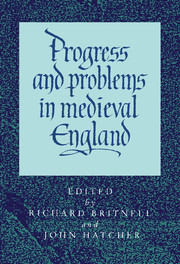Book contents
- Frontmatter
- Contents
- List of figures
- List of maps
- List of tables
- List of contributors
- Edward Miller: an appreciation
- List of abbreviations
- 1 Economic development in the early twelfth century
- 2 Lothian and beyond: the economy of the ‘English empire’ of David I
- 3 Boroughs, markets and trade in northern England, 1000–1216
- 4 Peasant deer poachers in the medieval forest
- 5 The growth of London in the medieval English economy
- 6 The bankruptcy of the Scali of Florence in England, 1326–1328
- 7 The English export trade in cloth in the fourteenth century
- 8 A medieval tax haven: Berwick upon Tweed and the English crown: 1333–1461
- 9 Taxation and communities in late medieval England
- 10 Peasants and the collapse of the manorial economy on some Ramsey Abbey estates
- 11 The famuli in the later Middle Ages
- 12 The great slump of the mid-fifteenth century
- 13 Lorenzo de' Medici's London branch
- 14 The trade of late medieval Chester, 1500–1550
- Bibliography of Edward Miller's published works
14 - The trade of late medieval Chester, 1500–1550
Published online by Cambridge University Press: 05 June 2012
- Frontmatter
- Contents
- List of figures
- List of maps
- List of tables
- List of contributors
- Edward Miller: an appreciation
- List of abbreviations
- 1 Economic development in the early twelfth century
- 2 Lothian and beyond: the economy of the ‘English empire’ of David I
- 3 Boroughs, markets and trade in northern England, 1000–1216
- 4 Peasant deer poachers in the medieval forest
- 5 The growth of London in the medieval English economy
- 6 The bankruptcy of the Scali of Florence in England, 1326–1328
- 7 The English export trade in cloth in the fourteenth century
- 8 A medieval tax haven: Berwick upon Tweed and the English crown: 1333–1461
- 9 Taxation and communities in late medieval England
- 10 Peasants and the collapse of the manorial economy on some Ramsey Abbey estates
- 11 The famuli in the later Middle Ages
- 12 The great slump of the mid-fifteenth century
- 13 Lorenzo de' Medici's London branch
- 14 The trade of late medieval Chester, 1500–1550
- Bibliography of Edward Miller's published works
Summary
Chester is an interesting exception to the generality of medieval English port towns at the end of the Middle Ages. It was on the commercial periphery of England, and the capital of an undeveloped region, yet while most of the larger centres in more prosperous areas were struggling through the aftermath of recession, Chester's trade was increasing and its population expanding. In part this was because the scale of Chester's commerce required a relatively small increase to trigger growth as new markets became accessible in Spain and Portugal, and in part because of the emerging Lancashire textile industry.
By 1500 Chester was a primary centre which had drawn a multiplicity of functions to itself over the centuries. It had prospered during the late Saxon period, and then under William the Conqueror and Edward I, as a strategic supply base for military operations in Wales and Ireland. The Palatinate generated a unique flow of administrative business to augment the town's markets, and in spite of its virtual exclusion from the wool trade and a marginal investment in the wine trade, Chester became the only town of significant size north of Shrewsbury and west of the Pennines.
Chester's hinterland was famously undeveloped. The Lancashire textile industry was scarcely visible before 1500 and Cheshire itself was a poorly drained county, routinely milked of its surplus by a succession of royal servants with short-term leases on Cheshire estates.
- Type
- Chapter
- Information
- Progress and Problems in Medieval EnglandEssays in Honour of Edward Miller, pp. 286 - 307Publisher: Cambridge University PressPrint publication year: 1996



